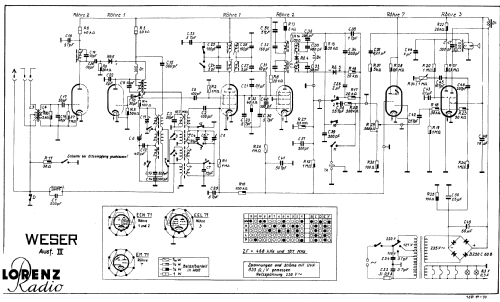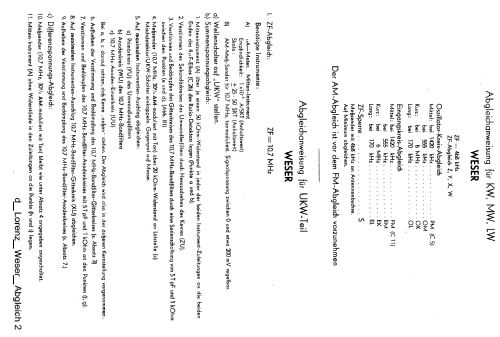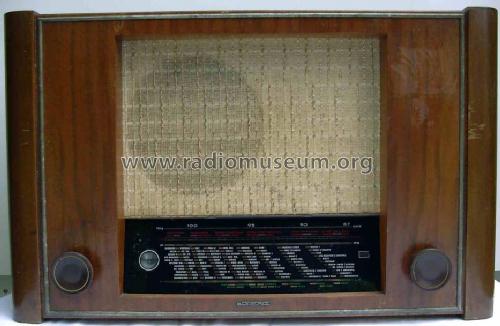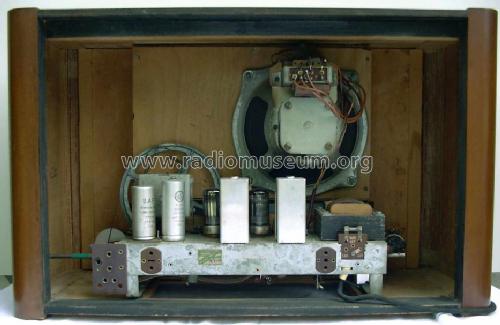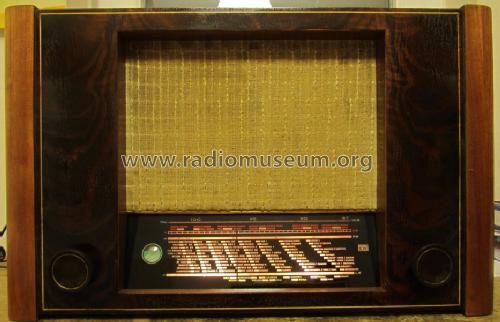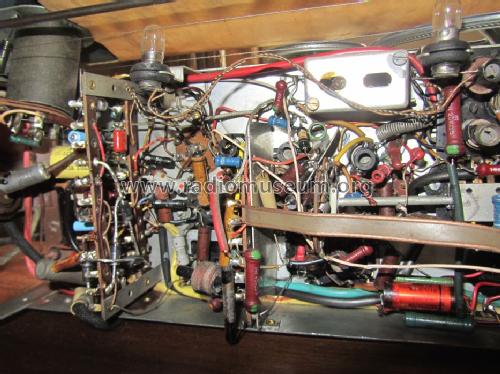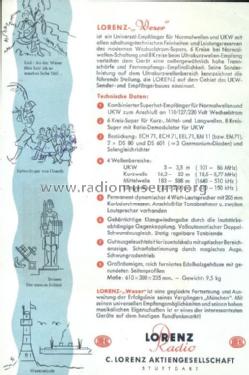- Paese
- Germania
- Produttore / Marca
- Lorenz; Berlin, Zuffenhausen u.a.
- Anno
- 1950/1951
- Categoria
- Radio (o sintonizzatore del dopoguerra WW2)
- Radiomuseum.org ID
- 3173
-
- Brand: SEL
Clicca sulla miniatura dello schema per richiederlo come documento gratuito.
- Numero di tubi
- 4
- Numero di transistor
- Semiconduttori
- Tr.Gl.=Metal-rectif.
- Principio generale
- Supereterodina (in generale); ZF/IF 468/10700 kHz; 2 Stadi BF
- N. di circuiti accordati
- 6 Circuiti Mod. Amp. (AM) 8 Circuiti Mod. Freq. (FM)
- Gamme d'onda
- Onde medie (OM), lunghe (OL), corte (OC) e MF (FM).
- Tensioni di funzionamento
- Alimentazione a corrente alternata (CA) / 110; 127; 220 Volt
- Altoparlante
- AP magnetodinamico (magnete permanente e bobina mobile) / Ø 21 cm = 8.3 inch
- Potenza d'uscita
- 4 W (qualità ignota)
- Materiali
- Mobile in legno
- Radiomuseum.org
- Modello: Weser W - Lorenz; Berlin, Zuffenhausen u
- Forma
- Soprammobile basso, con andamento orizzontale (grosse dimensioni).
- Dimensioni (LxAxP)
- 610 x 380 x 235 mm / 24 x 15 x 9.3 inch
- Annotazioni
- 3 Germanium-Dioden (DS601, 2× DS80) für UKW-Mischer und AM-FM Demodulation.
- Peso netto
- 9.5 kg / 20 lb 14.8 oz (20.925 lb)
- Prezzo nel primo anno
- 338.00 DM
- Fonte dei dati
- Kat.d. Rundf.Gr.Handel 1950/51 / Radiokatalog Band 1, Ernst Erb
- Bibliografia
- Funkschau (5016)
- Altri modelli
-
In questo link sono elencati 736 modelli, di cui 590 con immagini e 363 con schemi.
Elenco delle radio e altri apparecchi della Lorenz; Berlin, Zuffenhausen u.a.
Collezioni
Il modello Weser fa parte delle collezioni dei seguenti membri.
Discussioni nel forum su questo modello: Lorenz; Berlin,: Weser W
Argomenti: 1 | Articoli: 1
Das Chassis/die Schaltung von Lorenz Weser ist baugleich zu Schaub Smaragd. Daher kann die beim Modell Smaragd alt und Smaragd ab S/N 571601 hinterlegte technische Dokumentation verwendet werden. Möglicherweise existieren auch beim Weser 2 Varianten, deren Unterschiede hier gezeigt ist.
Es wäre daher interessant, beim Modell verschiedene Chassis-Ansichten zeigen zu können...
Das Funktionsprinzip wird hier beschrieben.
Bernhard Nagel, 09.Jan.08
